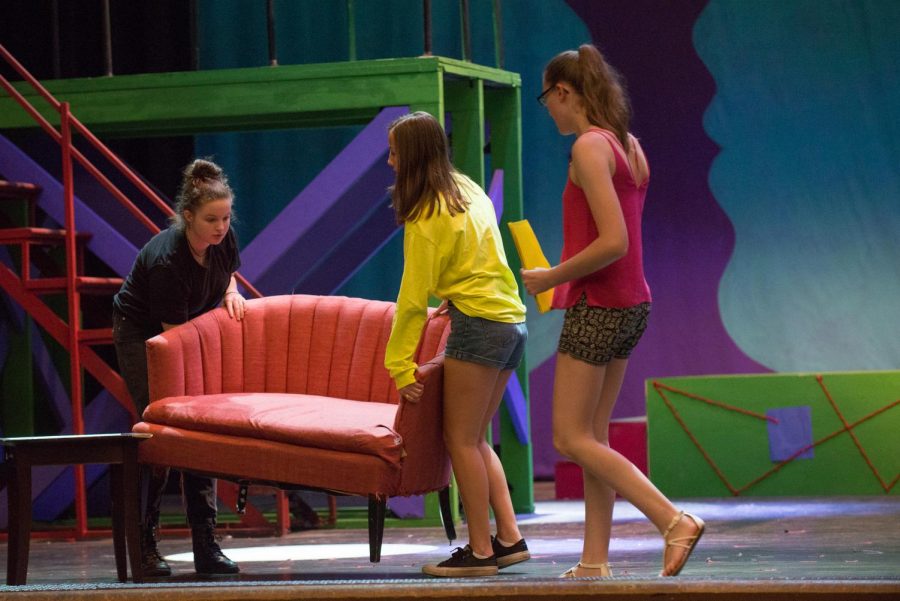Behind the scenes: Lagniappe crew’s tireless work pays off
October 6, 2017
While the main cast of New Trier’s annual Lagniappe-Potpourri production has been hard at work rehearsing in the weeks leading up to the performance, the Lagniappe crew has been with them every step of the way, working tirelessly behind-the-scenes to ensure a seamless performance for the actors.
The last few weeks before the performance dates, known as “tech week,” are primarily focused on combining the individual efforts made by both cast and crew in the months prior. “In the past few weeks, we got the whole stage crew on stage, and they loaded in the set,” said senior co-head Grace Verhoog. “The pit band came in, put their instruments in, and the actors started rehearsing on the set. Now what we’re doing is rehearsals with everyone – we’re basically going through the show and stopping when there’s something wrong.”
Tech week can become a time-consuming experience for many of the crew members, as the commitment required of them for the show along with academic stress can be challenging to juggle.
“As school’s starting to ramp up now, that’s when we’re really starting to get into [practicing],” said Verhoog. “It’s definitely been more stressful with academics, but it hasn’t been too horrible.”
Sophomore costume crew member Lillian Jones had a similar perspective. She said that while Lagniappe is noticeably time-consuming, the benefit of rehearsing before and during the past summer was apparent. Jones said, “Homework-wise, it hasn’t been that bad since we usually get out around 6:00, but [for tech week] we’re leaving at 8:00, and we haven’t really figured out what our academic schedules are going to be like.”
Despite the hectic nature of the rehearsals leading up to the performance, the Lagniappe crew has been able to keep up with the rigorous schedule, in part because of the organized manner in which work is divided amongst the crew. The crew is mainly divided into three areas, according to senior co-head, Alex DeTrempe.
“The scenic crew focused on painting – they painted the 50 foot-by-20 foot drops for the show,” said DeTrempe. “We also have costume crew, led by Bibi [Belknap Fernandez], and the build crew, where Sofia Mena and Claire Chevalier are the technical directors.”
For costume crew, the main goal is to create, accommodate and maintain the actors’ costumes in rehearsals and during the performance. “Once we start dress rehearsals, we’re all assigned three or four actors,” explained junior costume crew member Grace Lee, “and we’re responsible for making sure that they have the right clothes, and that they’re wearing the right costume at the right time, and quick changes.”
Just below the stage lies the pit band, which coordinates with the student composers to provide the live music that the audience hears. “There are two main parts – the student-written music that’s being acted and danced to during the actual production, and there’s scene change music,” said Temple. “The pit band provides [the] scene change music, which is typically arrangements of pop tunes.”
As with costume crew, the focus of the pit band during tech week was mainly to coordinate with the cast to figure out proper timing of the music, according to junior pianist Alexandra Riedinger. “Our primary role is to play the music for the songs the cast sings and dances to,” said Riedinger.
Even with all of these groups, there are still countless positions that encompass all aspects of Lagniappe. Spanish teacher Kerri Simons, a writing and composing mentor this year, said, “There’s choral directors and choreographers that work directly with the cast, technical directors and scenic designers that oversee the crew, sound designers, and other similar jobs. At the top of it all are the producers.”
With so many dynamic parts to the crew, conflicts do arise from time to time as the cast and crew figure out how to coordinate smoothly. “If the communication wasn’t 100% [correct] earlier, and we get to tech [week] and we have different ideas,” explained DeTrempe, “that can make it a lot more difficult, but we’re always able to resolve it – the directors and choreographers are flexible.”
Despite the challenges that come with creating such a large production, the experience as a whole is unbelievable and worth the hard work, according to the crew members.
From the writing to the lighting, Lagniappe is almost completely student-run, with the sponsors and mentors stepping in only to provide guidance and help with decisions. “Students do everything. My job is to develop students into effective leaders,” said Simons.
Moreover, almost everyone on Lagniappe agrees that they enjoy seeing their efforts come together to form the final play and the journey they experienced with one another.
“I’m not actually on the run crew, so I get to watch from the audience,” said senior assistant costume designer Noah Zelinsky. “I get to see everything that we’ve done, and that’s super cool.”
Jones loves how she gets to be with her friends while being involved with the play at the same time. She said, “Costume crew is very small, so we’re all very close. The crews are like small families, so no matter how little or how many friends you have, you’ll always make new ones.”
The close community is part of what makes Lagniappe comfortable to join for prospective cast and crew members. For students who want to get involved, Verhoog provides some words of wisdom.
“Just do it. Do everything you can to get involved in the theatre program,” explained Verhoog. “I’ve done everything from lighting to sound to props – try to get into all aspects of the theatre program. It’s a great opportunity.”











































